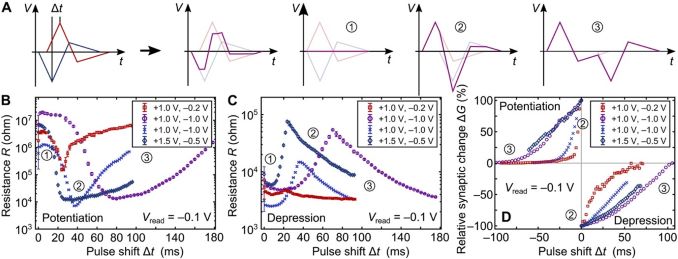We are at the beginning of a Data Age. There is a wide range of rapidly growing data-centric technologies spanning Big Data, the Internet of Things, transport, medicine, electric vehicles, security, entertainment, and neuromorphic computing for Artificial Intelligence. Our approach to finding more energy-efficient device technology to handle data in a better wat, e.g. with oxide memory-based devices.
Our three main projects in the field of low-power non-volatile memory (NVM) and neuromorphic computing are funded though Prof. Driscoll's Royal Academy of Engineering Research Chair, her ERC Advanced Grant, and an ECCS-EPSRC grant in collaboration with researchers from the USA. Here, we provide a general overview over our research in this field.
In RAM devices, information is stored in the form of charge on a dedicated capacitor (RRAM) or the charge on the gate terminals of two cross-coupled inverters (SRAM). Charge is prone to leaking out of such terminals, which makes the fast charge-based memories volatile. Our approach to designing new and energy-efficient NVM relies on nanoengineering of oxide thin films, where information can be stored using different material properties. Such properties are changed by voltage, i.e. change in stable electrical resistance, or change in direction of ferroelectric polarisation. In the first case (resistive switching), we are exploring the arrangement of oxygen vacancies or cation vacancies. In the second case (ferroelectric), we are studying changes in polarisation in CMOS-compatible pseudo-binary oxides.
In terms of neuromorphic systems, we aim to use the above NVM devices to emulate brain-like features, such as in-hardware learning, spike-based processing, temporal and spatial locality, resilience to noise, adaptability, and analogue processing - features not commonly found in today's mainstream computing hardware. Such neuromorphic systems could be the future of AI-centric hardware. From an energy point of view, new hardware is critical since there is an unprecedented and unsustainable rise in the demand for computing power, doubling every 2-3 months, largely fuelled by AI.
Neuromorphic behaviour is shown by doped amorphous HfO2 films with a new nanocomposite structure not observed in amorphous films before. The films give highly uniform resistive switching behaviour by an interface mechanism in which oxygen vacancies are engineered in by the doping, and pre-formed conducting channels in the composite provide contact to an ultrathin interface layer. This unique structure enables the uniform behaviour with excellent device characteristics. DOI: 10.1126/sciadv.adg1946
A University press release on the above work is found here.
And a podcast on the above work is here.
We founded the Cambridge Centre for Neuromorphic Computing, Neucam, in 2023 (https://www.neucam.msm.cam.ac.uk/)
Example Recent papers in Energy Efficient Oxide Materials for ICT
Hellenbrand M, MacManus-Driscoll JL, Multi-level and Gradual Resistive Switching in Hafnium-oxide-based Devices, Nano Convergence, https://doi.org/10.1186/s40580-023-00392-4; Sept. 2023, 10.
Hellenbrand M, Bakhit B, Dou H, Xiao M, Hill MO, Sun Z, Mehonic A, Chen, A Jia QX, Wang H, MacManus-Driscoll JL, Thin-film design of amorphous hafnium oxide nanocomposites enabling strong interfacial resistive switching uniformity, Science Advances, https://doi.org/10.1126/sciadv.adg1946; Jun. 2023, 9, eadg1946.
De H-Ora M, Nicolenco A, Peda M, Sun Z, Lee SB, Maity T, Sort J, MacManus-Driscoll JL, Voltage Control of Magnetism in Cobalt Ferrite Nanopillars, APL Materials, https://doi.org/10.1063/5.0147665; May 2023, 11, 051105.
Kunwar S, Jernigan Z, Hughes Z, Somodi C, Caravelli F, Roy P, Zhang D, Wang H, Jia Q, MacManus-Driscoll JL, Kenyon G, Sornborger A, Nie W, Chen A, An interface type memristor for artificial synapses and neuromorphic computing, Advanced Intelligent Systems, http://doi.org/10.1002/aisy.202300035; Apr. 2023, 2300035.
Crema APS, Istrate MC, Silva A, Lenzia AV, Domingues L, Hill MO, Teodorescu VS, Ghicad C, Gomes MJM, Marques PL, MacManus-Driscoll JL*, Silva JPB*, Ferroelectric orthorhombic ZrO2 thin films achieved through nanosecond laser annealing, Advance Science, http://doi.org/10.1002/advs.202207390; Mar. 2023, 2207390.
Jain A, Rembert T, Taper S, Symonowicz J, MacManus-Driscoll JL, Monserrat B, Di Martino G, Operando optical tracking of oxygen vacancy migration and phase change in few-nm ferroelectric HZO films, Advanced Functional Materials, https://doi.org/10.1002/adfm.202214970, Mar. 2023, 2214970.
Silva JPB Istrate MC, Hellenbrand M, Jan A, Becker MT, Symonowicz J, Figueiras FG, Lenzi V, Ghica C, Romanyuk Konstantin N, Di Martino G, Marques L, MacManus-Driscoll JL, Ferroelectric orthorhombic ZrO2 thin films with negative piezoelectric coefficient, achieved through substrate orientation control, Applied Materials Today, https://doi.org/10.1016/j.jmat.2022.11.010, Feb. 2023; 30, 101708.
Wu R, Li W, and MacManus-Driscoll JL, Exemplary Tuning of Ferroics Using Large Area Interfaces Formed in Epitaxial Superlattices and Nanocomposite Films, Materials Horizons, http://doi.org/10.1039/d2mh01527g; Feb. 2023,10, 1060-1086.
Prof. Driscoll warmly welcomes enquiries from those who wish to join the group, from PhD to postdoc to visiting fellows and visiting academics. For opportunities about joining the group, see here.
For a full list of MacManus-Driscoll publications, please see: https://scholar.google.co.uk/citations?user=-lYrze0AAAAJ&hl=en

